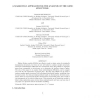Free Online Productivity Tools
i2Speak
i2Symbol
i2OCR
iTex2Img
iWeb2Print
iWeb2Shot
i2Type
iPdf2Split
iPdf2Merge
i2Bopomofo
i2Arabic
i2Style
i2Image
i2PDF
iLatex2Rtf
Sci2ools
IJFCS
2008
2008
A Markovian Approach for the Analysis of the gene Structure
Hidden Markov models (HMMs) are effective tools to detect series of statistically homogeneous structures, but they are not well suited to analyse complex structures. Numerous methodological difficulties are encountered when using HMMs to segregate genes from transposons or retroviruses, or to determine the isochore classes of genes. The aim of this paper is to analyse these methodological difficulties, and to suggest new tools for the exploration of genome data. We show that HMMs can be used to analyse complex genes structures with bell-shaped distributed lengths, modelling them by macro-states. Our data processing method, based on discrimination between macrostates, allows to reveal several specific characteristics of intronless genes, and a break in the homogeneity of the initial coding exons. This potential use of markovian models to help in data exploration seems to have been underestimated until now, and one aim of our paper is to promote this use of Markov modelling.
| Added | 12 Dec 2010 |
| Updated | 12 Dec 2010 |
| Type | Journal |
| Year | 2008 |
| Where | IJFCS |
| Authors | Christelle Melo de Lima, Laurent Gueguen, Christian Gautier, Didier Piau |
Comments (0)

